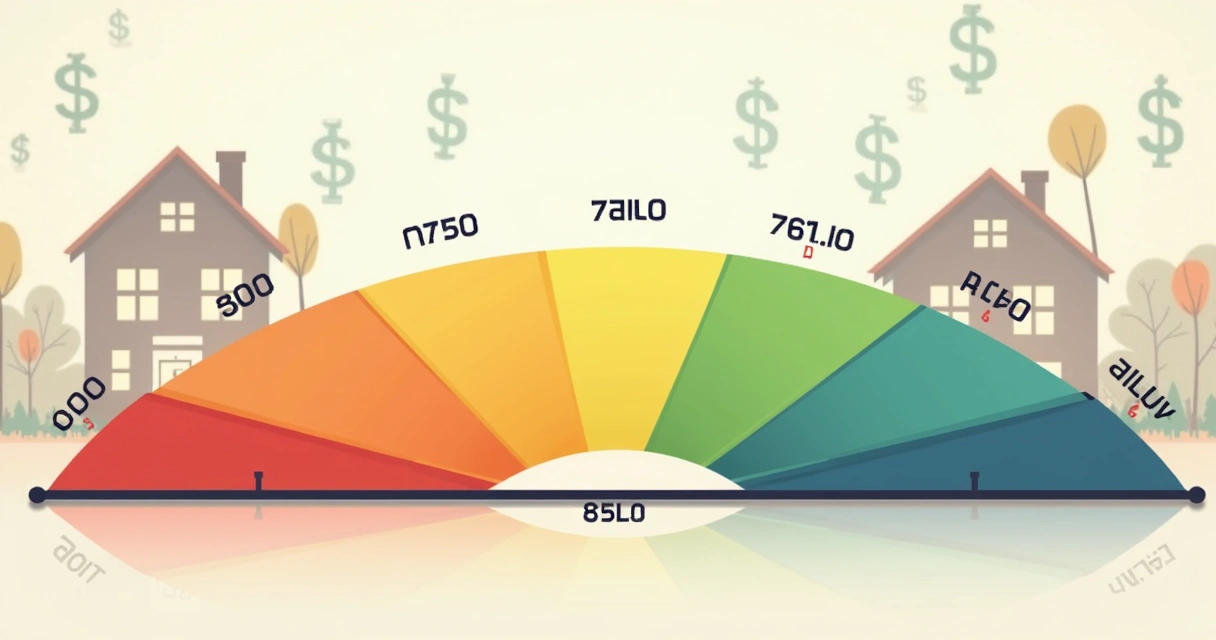Every time I’ve walked someone through the maze of US mortgage approval, I’ve seen the same question return: “What does my credit profile really mean for my home loan?” For many, unlocking that answer can turn dreams of homeownership into reality—or make it feel just out of reach. With so much at stake, I believe it’s worth slowing down and understanding, step by step, how those three digits steer your path to a mortgage. That’s exactly what I want to do here, blending my experience with the latest research, practical stories, and a clear explanation from the first credit inquiry to the closing table.
What is a credit score and how is it calculated?
At its core, a credit score is a number lenders use to estimate how likely you are to repay borrowed money. It’s an attempt to translate your borrowing and payment habits into something instantly readable. When I first studied these systems, I noticed how much weight they put on consistency—borrowing sensibly, paying back what you owe when you agreed, and not stretching yourself thin.
The most popular gauge is the FICO score, developed by the Fair Isaac Corporation. FICO scores range from 300 to 850, with higher numbers marking a stronger credit history. Most major lenders—including mortgage providers—prefer using FICO because it’s standardized and widely recognized. Another scoring model, VantageScore, is growing but hasn’t dethroned FICO for mortgage decisions.
The three main US credit bureaus—Experian, Equifax, and TransUnion—each maintain their own record of your credit interactions. They gather reports from credit card companies, lenders, and other financial institutions, storing detailed histories about your borrowing.
- Experian tracks your payment records and balances with credit cards, loans, and more.
- Equifax maintains similar data and sometimes reports items slightly differently.
- TransUnion also builds a profile from your open accounts, collection activities, and inquiries.
Each bureau might display a slightly different score, since not every creditor reports to all three. Mortgage companies often use a blend of these figures, taking the middle score or averaging them depending on the loan product.
It’s not just the number—it’s the story behind it.
Which factors shape your credit health?
When I break down these credit models for clients, I focus on the five main building blocks:
- Payment history (around 35%): The single biggest piece. Missed or late payments hurt; regular, timely payments help.
- Amounts owed (around 30%): This is sometimes called credit utilization. Having a high balance compared to your available credit lines can weigh you down.
- Length of credit history (about 15%): Older accounts that have been managed responsibly carry more weight than brief flashes of borrowing.
- Types of credit (around 10%): Lenders like to see variety: credit cards, car loans, a mortgage. It shows you can handle different types of debt.
- Recent credit inquiries (about 10%): Each time you apply for new credit, a “hard inquiry” appears. Too many in a short time can suggest risk.
According to a report to Congress from the Federal Reserve, these models must not use certain personal attributes like race or gender, focusing purely on financial data such as payment record and current obligations.
From my perspective, a big part of credit health is invisible—a sense of stability, a series of responsible choices, and the ability to recover if you hit a rough patch. But when it comes time for a lender to check, the score sums it up, flaws and all.

How does your credit rating influence mortgage approval?
Every mortgage lender in the US checks your credit strength before offering you a loan. They’re not just interested in approval—they care about how much risk you represent. According to guidance from the Consumer Financial Protection Bureau, higher scores tend to unlock better deals: lower interest rates, smaller down payments, and sometimes more flexibility with loan amounts.
The math is simple: The higher your number, the less you’re likely to pay for your mortgage over time. With a strong record, banks may offer you more competitive rates. With a weaker one, they often hike up rates to offset risk, or may decline to lend at all.
A small difference in credit score can mean big dollars over the life of your mortgage.
I think a story often explains this best. A friend of mine applied for a mortgage with a FICO in the low 700s—respectable, but not flawless. The rate offered was about 0.5% higher than what a borrower with a mid- to high-700s score could have claimed. The difference? Nearly $20,000 in extra interest over 30 years. For first-time buyers, those margins matter.
What does research say about credit thresholds?
Statistics show US mortgage lending is more stringent than a generation ago. Federal Reserve data highlights that after the 2008 financial crisis, the median borrower’s credit rating for a new home loan climbed about 40 points, and fewer buyers with scores below 620 have been able to qualify.
Furthermore, a study of minimum credit rules found that strict lender rules can disproportionately limit access for younger applicants or those in middle-income neighborhoods. The conclusion I draw is that the scoring system has real-life impacts, not just on who qualifies, but which communities are able to purchase homes.
At Heart Mortgage, I see this every day—how rules and thresholds shape who can afford to buy, and who’s left waiting. Sometimes fixing one small credit misstep opens the door to a whole new range of options.
Score ranges for common US mortgages
When I advise clients, I usually break things down by score ranges. While the numbers shift slightly depending on the loan product and the economy, these boundaries usually apply:
- 760 and above: Best rates and loan terms, including conventional mortgages.
- 700 to 759: Still excellent, with competitive interest rates and good approval odds.
- 660 to 699: Moderate, with slightly higher rates but still accessible loan products.
- 620 to 659: Considered borderline. Many conventional loans set 620 as a minimum, and terms may be less favorable.
- Below 620: Typically requires government-backed loans or special programs, such as FHA loans. See this detailed guide for mortgages for low credit buyers.
Each 20-point jump can lower your borrowing costs.
If you want to see how the absolute top of the range looks, you can check what the highest scores really mean in the real world.
Accessing your credit report and spotting errors
One simple thing I tell everyone: You are allowed to see your own credit reports, and you should. US law gives you the right to a free copy every 12 months from each of the three bureaus via AnnualCreditReport.com. (This is especially true as a mortgage application approaches—mistakes can take time to fix.)
When you check, look for:
- Accounts that aren’t yours
- Incorrect balances or payment statuses
- Outdated negatives, such as paid-off debts still shown as “unpaid”
- Any suspicious hard inquiries
If you find errors, follow the bureau’s dispute process. In my experience, it sometimes takes persistence and supporting documents, but errors can—and do—get removed. This is backed up by guidance from the Consumer Financial Protection Bureau.

How to boost your credit before you buy a home
Over the years, I’ve gathered a list of truly effective habits. None are flashy, but together, they work. If someone asks me how to lift their score before a mortgage, I always start with these:
- Pay every bill on time. Even small delays can lower your score.
- Keep credit card balances low (ideally under 30% of the available limit). Utilization matters a lot, even if you have never missed a payment.
- Avoid applying for new credit in the months before a mortgage. Too many new accounts or inquiries can raise red flags.
- Don’t close old accounts, unless absolutely necessary. Older accounts contribute to your average credit age, which can help your profile.
- Address any collections or past-due accounts as soon as possible. Bringing them current, or even negotiating a “pay for delete,” can strengthen your standing.
I think a regular “credit checkup” makes sense—kind of like a physical for your finances. You spot surprises, spot patterns, and you gain a sense of control.
For a more comprehensive step-by-step approach, I recommend reading a good mortgage application checklist.
Other things that influence mortgage approval
While your score is incredibly influential, lenders also look at your income, employment stability, debt-to-income ratio, and the type of loan you want. For example, some government-backed programs are more forgiving if your overall financial picture is solid.
I often see buyers stress over the perfect score. But sometimes, a steady job and a decent savings cushion tip the scales. Each lender applies these rules a little differently, adding to the mystery.
Why regular credit monitoring makes sense
In the US, each of us has legal rights under the Fair Credit Reporting Act (FCRA). You have the right to:
- Receive a full disclosure of all credit report information
- Know who has accessed your file and why
- Dispute errors and secure quick corrections
- Restrict access to your report (for example, via a “credit freeze”)
Because identity theft and errors are so common, I check my own reports at least twice a year. There are both free and paid monitoring services, but even just using your free annual reports is a strong first step.

Does the system need to change?
Credit scoring is powerful—but not perfect.According to the Urban Institute, the way lenders assess your borrowing track record hasn’t updated much in two decades. It raises fair questions about whose profiles are being overlooked, or who could qualify for better mortgages if newer data points were used.
I see this firsthand at Heart Mortgage: Some promising buyers lose out simply because the model is slow to adapt to their real-life finances. That’s why we stay on top of changes, coach our clients to succeed under today's rules, and constantly check for new solutions that could help more people achieve homeownership.
For anyone thinking about taking the leap into homeownership, I truly believe understanding your score gives you power. It lets you shop for your mortgage confidently and spot trouble before it impacts your dreams. For more practical tips and news, there’s a wealth of guides and insights about credit out there.
Your first step toward homeownership is in your hands
In my experience, the path to a mortgage always starts with curiosity: taking a real look at your credit standing and asking, “What could I do right now to get better terms, safer options, or even a ‘yes’ where today it’s a ‘not yet’?” I’ve seen the turnaround happen for people who thought homeownership was out of reach—sometimes, just one move made the difference. At Heart Mortgage, we help guide clients through every step, whether their record is spotless or needs a little work. I encourage you: Take a look at your credit, ask questions, reach out for advice, and open the first door on your way to a place you can call home.
Frequently asked questions
What is a good credit score for a mortgage?
Most lenders consider a score of 700 or higher as strong for mortgage approval, unlocking better rates and more mortgage options. Conventional loans may consider applicants starting at 620, but anything from 740 and above is likely to qualify for the best deals. It’s always wise to double-check with your chosen lender or advisor.
How does credit score affect mortgage rates?
Lenders offer their best interest rates to borrowers they see as least risky; a higher score shows you’re more reliable. Even a small difference—say, 20 or 30 points—can slightly lower your interest rate, saving thousands over a 30-year loan. According to recent guidance from the CFPB, stronger profiles don’t just make approval easier—they make the loan itself cheaper.
Can I get a mortgage with bad credit?
Even with lower scores, home buying isn't impossible. There are loan programs designed for buyers with bumpy financial histories, such as FHA loans. They consider applicants with credit that’s well below “prime,” often starting around 580. Good advice, supporting documents, and a bigger down payment can also help; see more in this guide for low credit homebuyers.
How can I improve my credit score fast?
Start by paying every bill on time, reducing high credit card balances, and checking reports for errors. Avoid applying for new lines of credit right before your mortgage application. Sometimes, negotiating with creditors to update or remove negative marks helps, especially for debts that have been settled.
What credit score do lenders usually require?
For most conventional mortgages, 620 is the common minimum threshold. Government-backed loans can accept lower numbers, especially if you have solid income or collateral. Lenders also look at other factors, so a score a bit below the “line” might still work if the rest of your application is strong. For a deeper look at preapproval, I often recommend this step-by-step mortgage preapproval guide.





